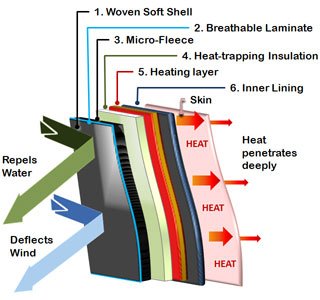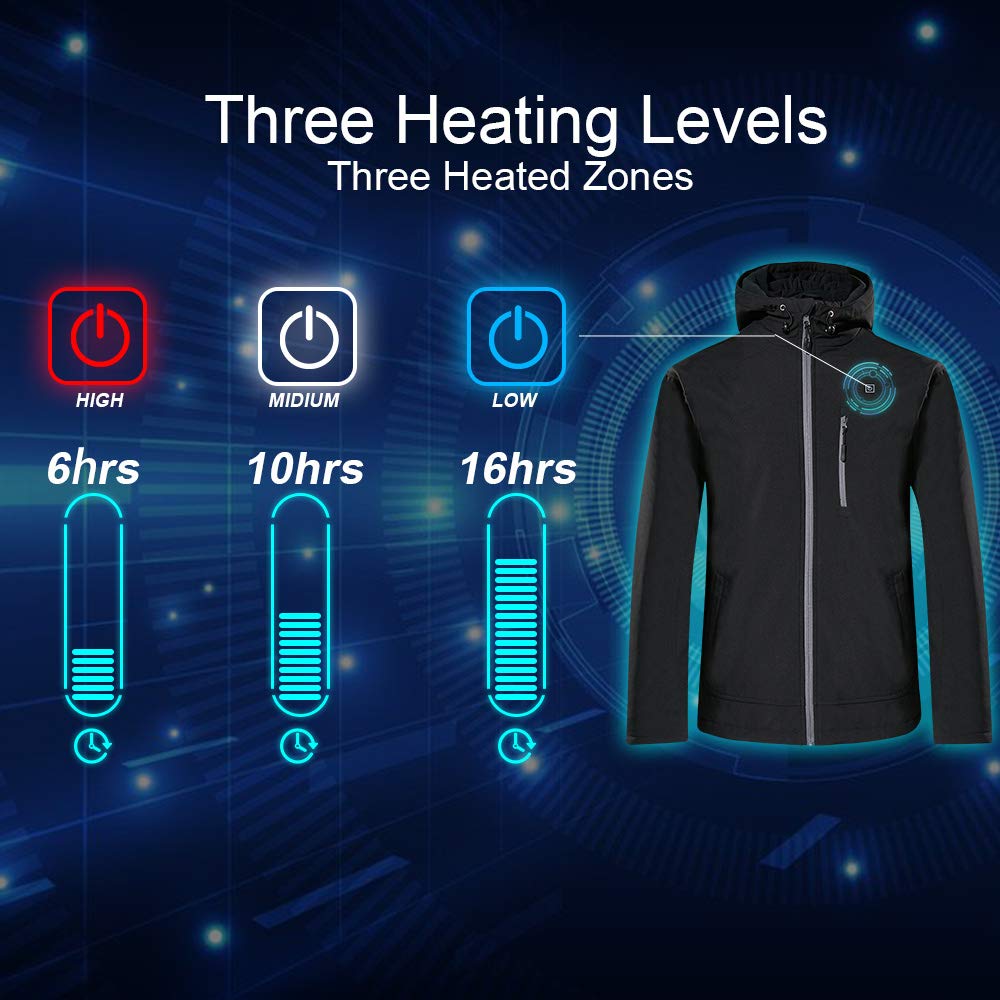Imagine you could take your home’s central heating system around with you everywhere you go, even in the most inclement conditions.
Essentially, that’s what a heated jacket can do for you. To find out more, read our handy guide and see for yourself.
1. What is a Heated Jacket?
A coat is a marvellous thing, it can keep the rain off your back and the cold off of your skin, but it cannot produce any actual heat. In fact, all that even the thickest coat can do is keep the body warm by trapping layers of air between it and the body wearing it.
When the body is cold, it diverts blood away from the extremities and towards the core. This is why your fingers and toes can sometimes become numb in cold weather. This is also why you usually feel very tired after too long spent in cold weather, as your body is constantly exerting much needed energy in order to keep you warm.
A heated jacket is designed to put a stop to all that. As the name suggests, a heated jacket is a jacket with its own internal heating system built into it.
In the past, such garments have been impractical and generally quite cumbersome, but today, newer, slimmer and more comfortable heated jackets are being produced. These can be worn on their own, or as an addition to your favourite winter coat.
Most new heated jackets can be customised to emit as much or as little heat as required by the wearer and are stylish enough to appeal to anyone. With this said, they are usually designed with outdoor workers (e.g. construction workers, security personnel etc.) in mind.
As we shall see, today’s heated jackets are really a Godsend to those operating outside in cold weather.
2. How Do Heated Jackets Work?
Heated jackets are lined with small wires that carry a low electrical charge. In a way, this is not unlike the body’s own circulatory system, which keeps us warm via constant blood flow. When this charge passes through the wires, heat is produced by the jacket and transferred to the wearer.
The electrical charge usually emanates from a 3 or 7-volt battery, which is rechargeable and therefore never needs replacing. For some more advanced (and usually bulkier) garments, a 12-volt battery is used. The battery is accessible via a special pocket located somewhere on the jacket.
Most heated jackets place their focus on heating the body’s core. They do this via two rectangular panels on either side of the chest, with a third, larger panel that covers the back.

A waterproof membrane separates the heating elements from the wearer’s body. This makes the jackets safe to wear in wet or damp conditions.
However, no heated jacket is 100% waterproof and they should never be submerged in water (mainly because it damages the battery).
The actual temperature of the jacket is usually controlled manually. Most heated jackets feature 3 levels of heating, ranging between 40℃ and 55℃.
3. Benefits of a Heated Jacket
The immediate benefits of heated jackets are obvious. They allow the wearer to operate well, even in bitter cold, by providing a secondary heat source.
Another benefit comes from the fact that less layers are actually needed by the wearer, which allows for a greater degree of mobility. This is especially useful on the Doors or areas where intensive physical activity is required.
Pain relief is also a benefit, as the extra warmth provided by a heated jacket has been shown to promote blood circulation, which relieves pain from conditions such as rheumatism, arthritis and other ailments that can be aggravated by cold and damp.
Believe it or not, some of today’s heated jackets also feature USB-enabled pockets for charging various devices, as well as storing necessary items. So a key benefit is that you can charge your phone while it is in your pocket.
Heated jackets are also lightweight, which means that they don’t add to the wearer’s burden if he or she is carrying heavy bags or items.
4. How Long Do Heated Jackets Last?
The battery life of a heated jacket depends mainly on two factors, namely how high the temperature setting on the jacket is and the capacity of the power bank.
For example, if you have a lower quality battery and set the temperature to its highest setting, the jacket will not stay hot for very long, perhaps only a couple of hours. However, if you have a more powerful battery and keep the jacket on a low or medium setting, you should be able to get between 8 and 12 hours of heat out of it.
For certain (not all) heated jackets, extended life batteries are available and some models require batteries to be purchased separately, which gives you the chance to buy the battery that best suits your specific needs.
Another issue that can affect the battery life is whether or not you choose to charge a portable device from one of the USB-enabled pockets. This, of course, will also drain the battery.
Some jackets now feature heated sleeves or attachable gloves in addition to breast and back panels. This will also impact the life of the battery, as there are more areas requiring electrical charge. Some leading designs actually allow the wearer to adjust heat zones separately (for example, heating your pockets at full temperature while reducing the temperature of the back zone), which could also affect the battery life.

Two factors are especially important with regards to the battery; these are the voltage and the milliampere hour. Batteries with a higher voltage will enable the jacket to reach higher temperatures, while the milliampere hour pertains to the battery’s overall capacity. Consider this well before purchasing any type of heated garment.
5. Are Heated Jackets Safe?
Heated jackets are usually quite safe. Although the panels do get quite warm, protective materials inside the jacket ensure that there is never any risk of damage to the wearer’s skin.
A waterproof layer, placed around the heated panels themselves, removes any possibility of the jacket’s electrical components becoming wet, regardless of the weather.
Heated jackets do not use live electrical currents, so you can breathe a sigh of relief if you were worrying about electrocution. In fact, the voltage used is about as low as that of a small toy, so it is certainly nothing to worry about.
It may also be a surprise to learn that quite a few heated jackets are actually washer/dryer safe (take the battery out first though!).
Good quality heated jackets will not catch fire, as they are specifically designed not to do so. Limits on temperature are also present to help the wearer stay safe.
As an addendum to this, however, it is worth noting that some lower quality jackets do carry a slight fire risk due to bad or faulty wiring. There are a lot of heated garments on the market, and it would be wrong to simply say that none of them carry a fire risk.
Despite being mostly safe, the heating system in your home or your slow cooker carry with them a slight risk of fire, which must be considered at all times. It is recommended that you don’t buy the cheapest models, that you do your research thoroughly before making a purchase and that you investigate the wiring to make sure the jacket is safe before wearing it.
Most heated jackets will come with a warranty, and can be easily replaced if found to be faulty in any way.
6. Are Heated Jackets Waterproof?
By and large, heated jackets are not completely waterproof. Even the best winter coat you have can still get soaked if bombarded by enough rain for an extended period of time, heated jackets are no exception.
So although the heated elements are well protected and will not get wet, the jackets themselves are usually only water resistant, not waterproof.
Heated jackets are designed to withstand the cold temperatures and are often quite hard wearing. They are especially useful in strong winds or snow, and you always have the option of wearing a raincoat over the slimmer models.
7. How Do You Wash a Heated Jacket?
Heated jackets are actually easy to wash. The battery packs, heating panels and any other internal technology must, of course be removed first, but after that you can wash your jacket the same way you might wash any other coat or jacket.
It is advisable, however, to use a gentle wash cycle (not too hot) and to allow the coat to air-dry, rather than putting it in a tumble dryer. The dryer probably won’t ruin the jacket, but air-drying is better for the shape, structure and quality of the jacket overall.
Heated jackets have moved away from the cumbersome, awkward models of the past. Today’s heated jackets are sleek, high tech and often quite fashionable. They are a perfect addition to any outdoor worker’s wardrobe, but you really have to try one to see just how big a difference they can make.
8. What is the Material that is used?
Externally, heated jackets are usually made of specially treated polyester (often with a DWR coating). This is designed to be resistant to wind and rain, and to help keep warm air trapped within its layers, making them relatively effective even without the heating functions.
They usually sport a soft, comfortable inner lining, which can be made from any number of materials, such as fleece. Some designs feature removable hoods and gloves as well.
Heated jackets often take the form of softshell jackets, a type of outdoor clothing designed to bridge the gap between the outer layer and mid layer by keeping the wearer warm without restricting mobility.
The heat elements used in heated jackets are usually either thin steel plates or carbon fibres.
Carbon fibres are, as the name suggests, fashioned from carbon crystals. For context, remember that diamonds, one of the hardest substances known to man, are simply chunks of superheated carbon.
Carbon fibres, often interwoven with other materials to create a composite, are typically low weight, have a very high tensile strength and are highly heat and stress resistant. In short, they are the perfect material for a lightweight, hard wearing, heat producing jacket. This is probably why they are used in aerospace engineering, motorsports and anywhere else mankind might need an edge.